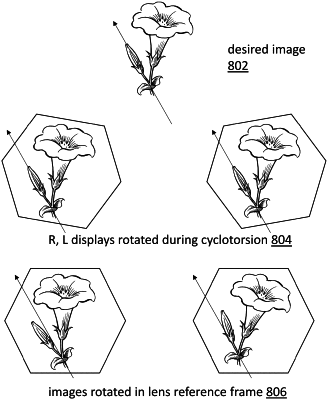| CPC G02C 7/048 (2013.01) [G02C 7/10 (2013.01)] | 17 Claims |

|
1. A system for estimating eye orientation comprising:
a first contact lens including one or more sensors for sensing first sensor measurements associated with the first contact lens for a first eye of an individual, and a first projector for projecting a first image onto the first eye;
a second contact lens including one or more sensors for sensing second sensor measurements associated with the second contact lens for a second eye of the individual, and a second projector for projecting a second image onto the second eye; and
a non-transitory computer-readable storage medium to store instructions executable by a processor, the instructions when executed causing the processor to perform steps including:
obtaining one or more filters including filter parameters that model constraints, including Listing's law, on individual motions of the first eye and the second eye and on relative motion between the first eye and the second eye;
configuring a first image orientation for projecting the first image onto the first eye;
configuring a second image orientation for projecting the second image onto the second eye;
obtaining the first and second sensor measurements;
applying the one or more filters to the first and second sensor measurements to estimate first and second lens orientations of the first and second contact lenses based on the first and second sensor measurements and the filter parameters, such that the first and second lens orientations satisfy the constraints; and
detecting a change in relative roll between the first and second contact lenses from the first and second lens orientations; and
updating the first image orientation of the first image and updating the second image orientation of the second image to apply respective rotations to the first and second images to compensate for the change in relative roll.
|